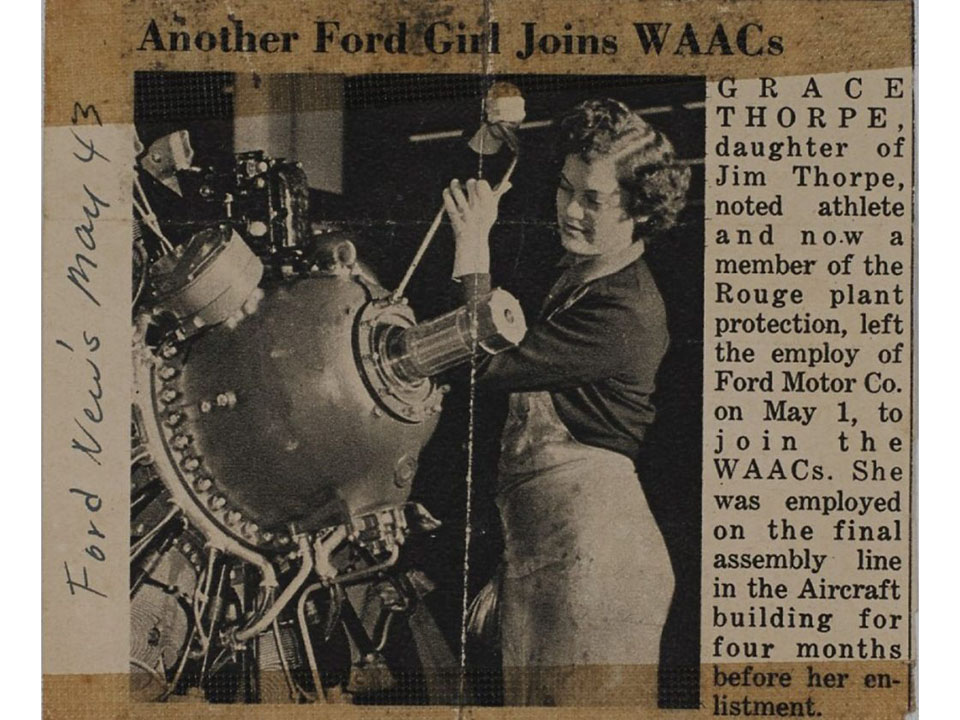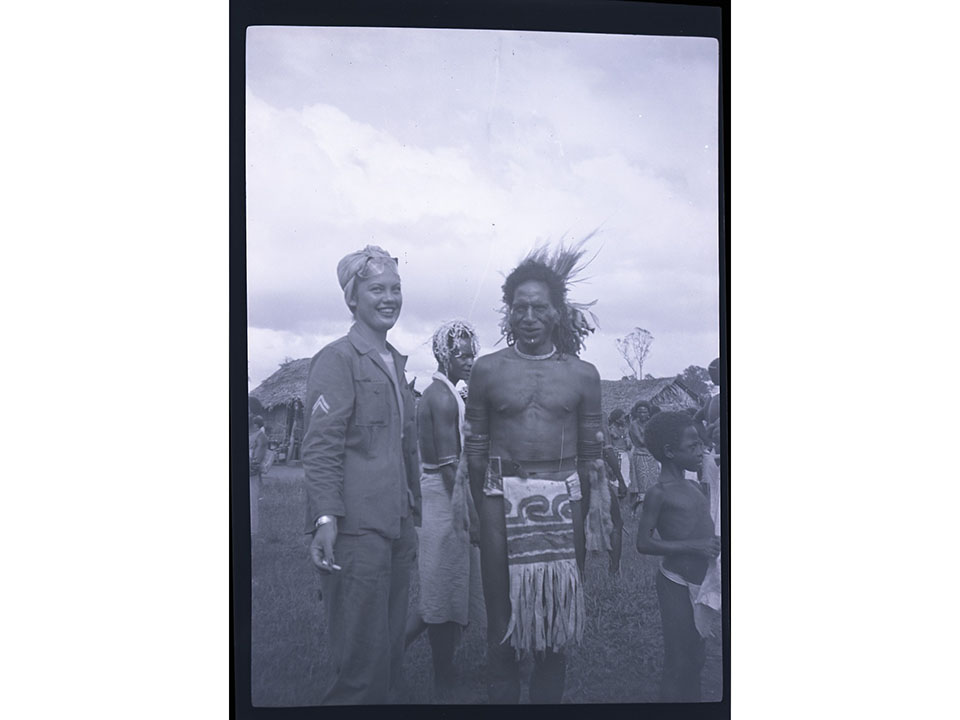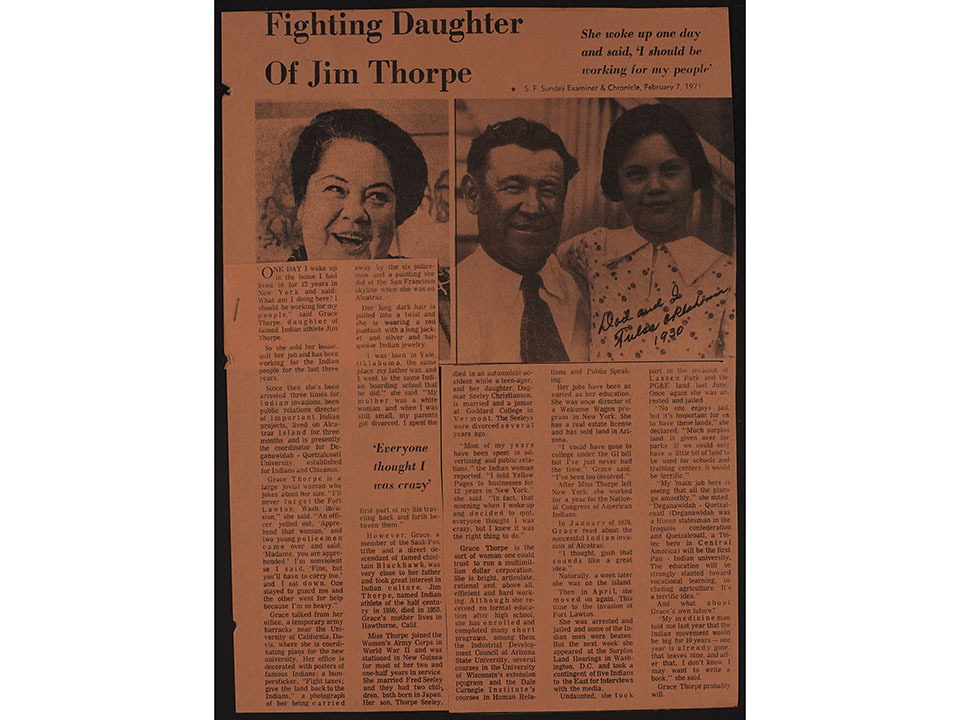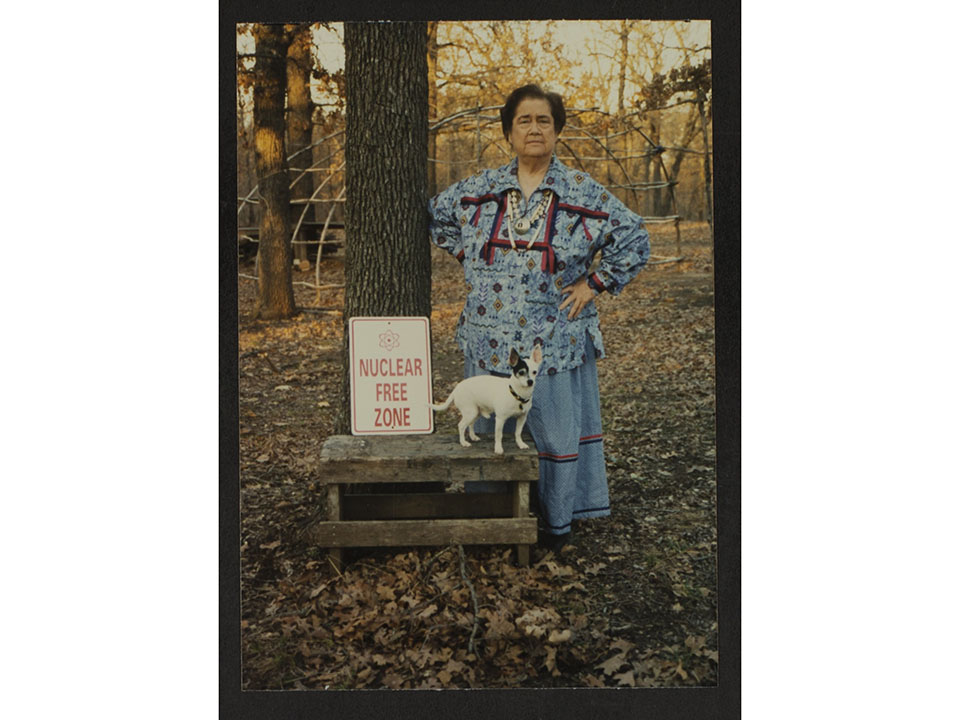Top image: Grace Thorpe attempting a field goal at the WAC Training Center at Fort Oglethorpe, Georgia, 1943. Grace F. Thorpe Collection, Folder 7; National Museum of the American Indian Archive Center, Smithsonian Institution.
Many reading this post are familiar with Jim Thorpe, one of the world’s best athletes, from his dominant performance in the pentathlon and decathlon at the 1912 Summer Olympics, to his professional career, most notably in football and baseball. You might be unfamiliar, however, with the incredible life of his daughter Grace. Grace served during World War II and was a tribal judge and anti-nuclear activist, shaping a remarkable legacy of her own as a steward for the rights of indigenous peoples and the environment, and for solidifying her father’s stature as the greatest all-around American athlete.
Just this past year, the National Museum of the American Indian digitized significant holdings in its Grace F. Thorpe collection, donated by the family to the Museum in 2015. Inside contains not only detailed documentation, including newspaper clippings and scrapbooks from her time in the Women’s Army Corps, both on the home front and in the Pacific theater, as well as her memories of her father and photographs from her time as an activist.
Grace was born in Oklahoma as the youngest of four children to Jim Thorpe and Iva Miller. She was of Potawatomi, Kickapoo, and Menominee heritage and a direct descendent of Sac and Fox chief Black Hawk, who disputed the treaty signed between his tribe and the US government to cede all land east of the Mississippi River, spurring the 15 week long Black Hawk War in 1832.
As a young child, Grace’s parents split up, and she spent time with both of them in Chicago and California. Grace attended St. Mary’s Academy, and then transferred to her father’s alma mater Haskell Indian School in Oklahoma. After the war began, Grace felt the call to contribute and in 1943 was hired to work on the aircraft assembly line at Ford Motor Company’s Rouge plant in Michigan. After four months at Rouge, Grace enlisted in the Women’s Army Corps saying she made the switch from war worker to WAC because, “of lack of ties. While some other woman, possibly one with a small child, could do my former job but would not be able to make the grade for enlistment.” She headed to Ft. Oglethorpe, Georgia for training and then was assigned to WAC recruiting, which took her to Montana and Arizona. With her father’s fame following her wherever she went, many press photos of Grace at the time show her slinging the pigskin while in uniform.
Newspaper clipping from Grace’s time at Ford’s Rouge Plant. 1943; Grace F. Thorpe Collection, Folder 7; National Museum of the American Indian Archive Center, Smithsonian Institution.
Next assigned to the Pacific, Thorpe continued her recruiting efforts in New Guinea, the Philippines, and Japan until the end of the war. Staying in Japan after she was discharged, Thorpe rose to Chief of the Recruitment Section at the Department of Army Civilians in Tokyo. There she married Lt. Fred Seely in 1946 and had two children, Dagmar and Paul.
Grace in New Guinea.1944; Grace F. Thorpe Collection, Folder 15; National Museum of the American Indian Archive Center, Smithsonian Institution.
Divorced in 1950, Grace raised her two children in Pearl River, New York. Tragically, her son Paul died in a car accident as a teenager, and this pain led Grace to eventually pursue new ventures in her life in education and tribal affairs. She coordinated the National Congress of American Indians Economic Development Conference and worked with the Native American Women’s Action Council and with Senator James Abourezk from South Dakota.
In 1969, an activist group occupied Alcatraz Island, lobbying to have this surplus federal land returned to American Indians, with the aspiration that the island and infamous shuttered prison be transformed into a Indian cultural center and school. Thorpe joined the occupation for three months, running publicity for the group. She became a key member of the occupy movement on surplus federal land across the country and lobbied in front of the Senate Appropriations Committee to support Indians who did not live on reservations.
Clipping from the San Francisco Sunday Examiner and Chronicle detailing Grace’s fight to have surplus lands returned to American Indians. 1971; Grace F. Thorpe Collection, Box 1, Folder 22; National Museum of the American Indian Archive Center, Smithsonian Institution.
Returning to school, Grace graduated with her undergraduate degree from the University of Tennessee at the age of 58. She also became consumed with another quest: to solidify her father’s athletic legacy, beginning with the restoration of his 1912 Summer Olympic gold medals. Calling into question his amateur status, Jim’s medals were stripped from him by the International Olympic Committee just one year after his historic win. Grace fought for years to have her father’s record restored, and in 1982 the Thorpe family was informed that Jim’s medals would be reinstated. However, the record shows him as co-champion, as the runner-ups' placements were not reassessed with Thorpe’s new status.
In 1996, Grace penned “Our Homes Are Not Dumps: Creating Nuclear-Free Zones,” raising awareness that American Indian tribes around the country have been excessively burdened and harmed by the nuclear industry and, specifically, the disposal and storage of nuclear waste on tribal lands. She relates in the piece, “I was a corporal, stationed in New Guinea, at the end of World War II when the first atomic bomb was dropped on Hiroshima. . . No safe method has yet been found for the disposal of such waste, the most lethal poison known in the history of humanity. It remains an orphan of the nuclear age. . . The utilities are using our names and our trust lands to bypass environmental regulations. The issue is not sovereignty. The issue is Mother Earth's preservation and survival. The issue is environmental racism.”
Grace celebrating her 70th birthday, posing with her dog and “Nuclear Free Zone” sign. 1991; Grace F. Thorpe Collection, Folders 119-121; National Museum of the American Indian Archive Center, Smithsonian Institution.
Grace continued her work in environmentalism and activism, as well as a circuit of public speaking engagements to cement her father’s place in sports history. She passed away in 2008 at the age of 86 of heart disease.
To explore more personal mementos of Grace’s life, visit the Grace F. Thorpe digitized collection via the Smithsonian Online Virtual Archives.
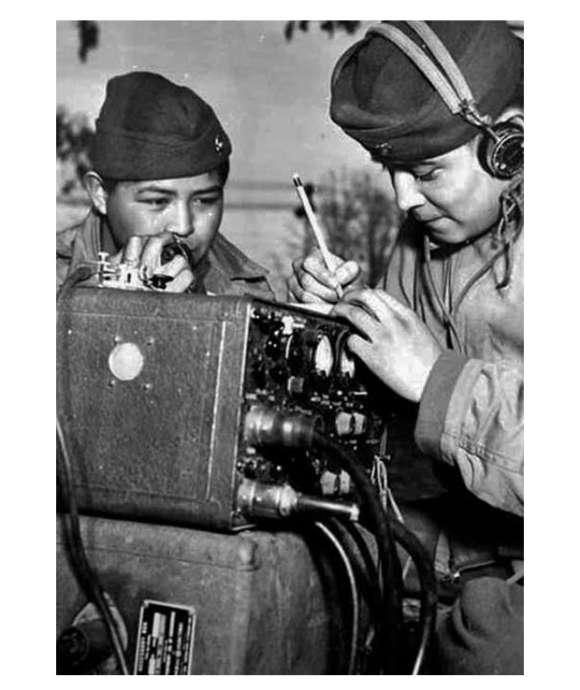
Native Words, Native Warriors: Telling a More Complete Story about Native American Code Talkers
While many Americans are familiar with the idea of “code talkers,” knowledge about the fuller lives, stories, and experiences of Native American Code Talkers is incredibly limited. The Smithsonian’s National Museum of the American Indian, in partnership with Native communities, wants to help change that.
Chrissy Gregg
Cite this article:
MLA Citation:
APA Citation:
Chicago Style Citation:

